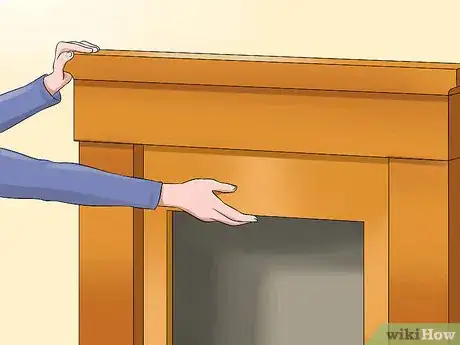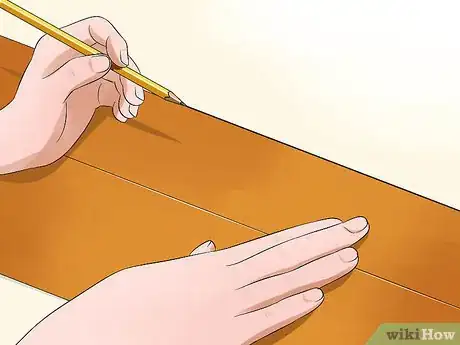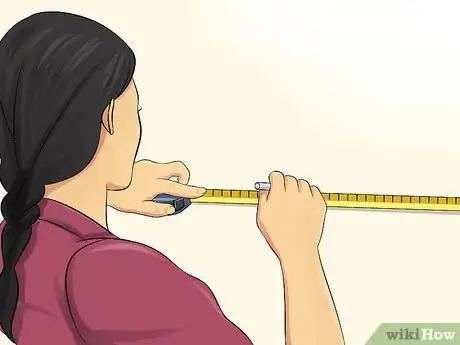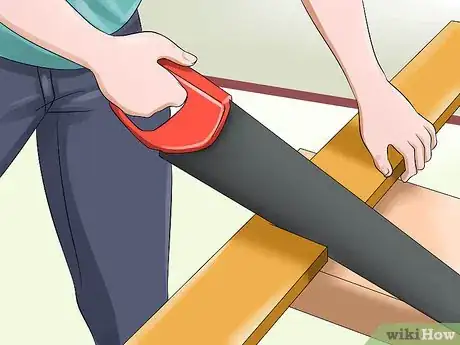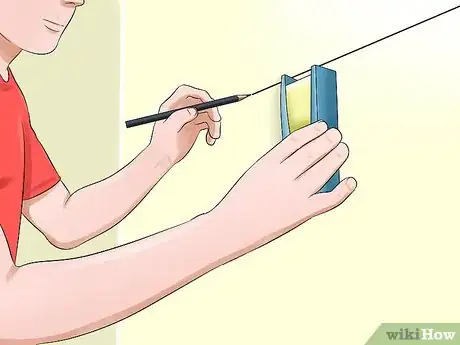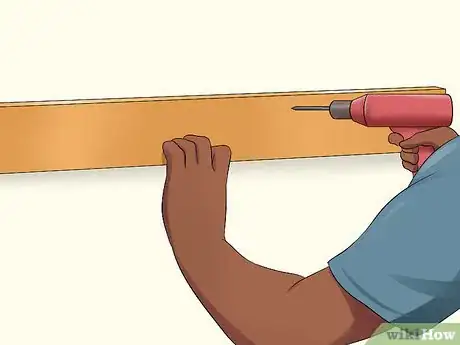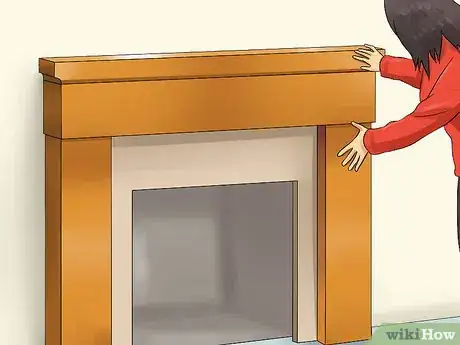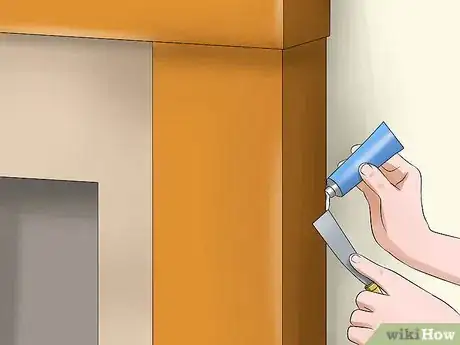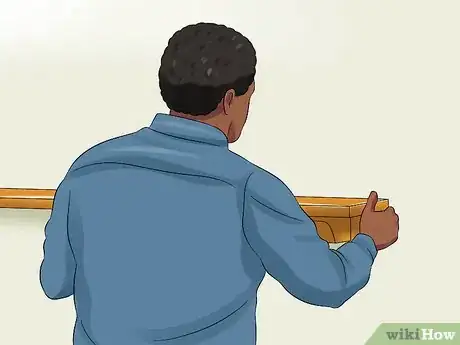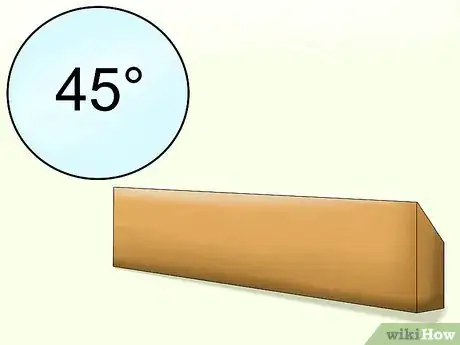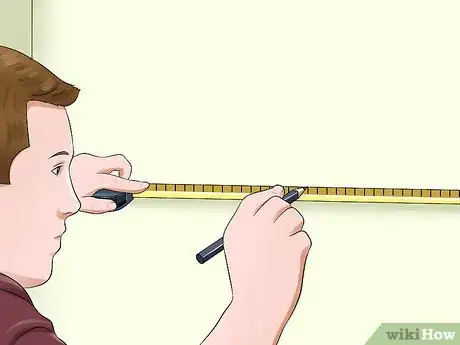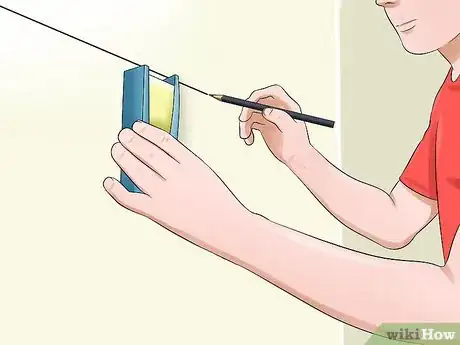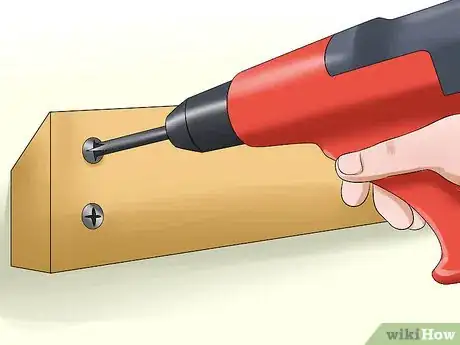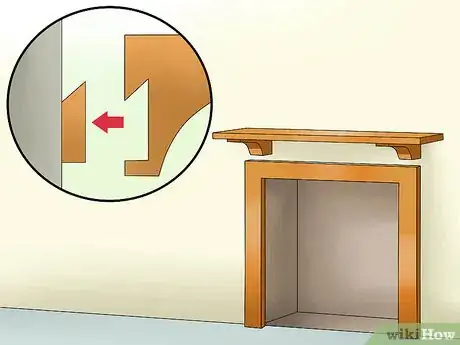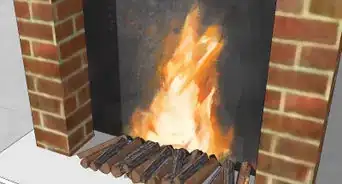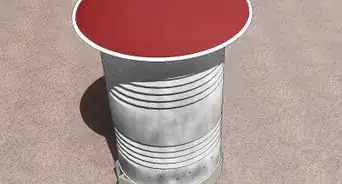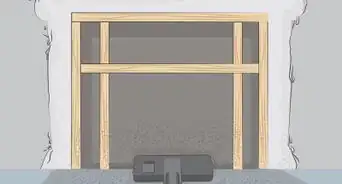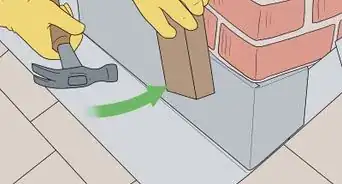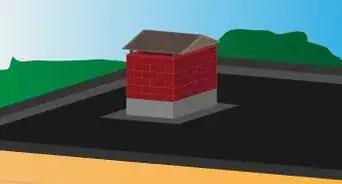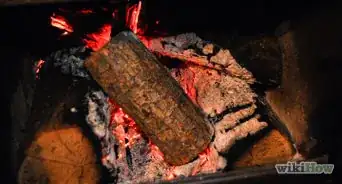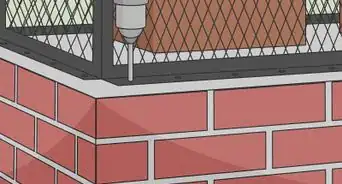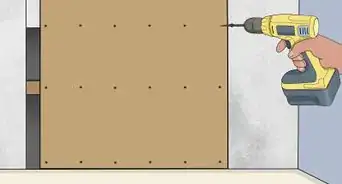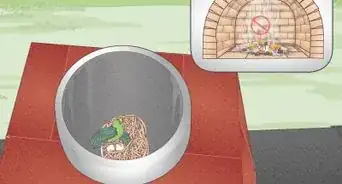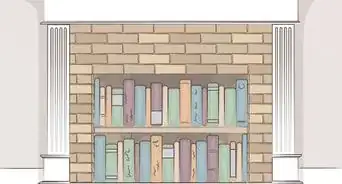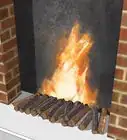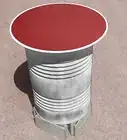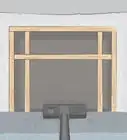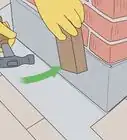This article was co-authored by Josh Goldenberg. Josh Goldenberg is a Residential Remodeling Expert and the Co-Founder of 5blox, based in the Greater Los Angeles area. With more than seven years of experience, Josh and his team specialize in luxurious and sustainable home renovations. 5blox is fully licensed and bonded.
There are 7 references cited in this article, which can be found at the bottom of the page.
This article has been viewed 95,930 times.
The addition of a mantel can greatly enhance the look of any fireplace as well as add a focal point to a room. Mantel kits can be purchased to create the right look for the fireplace, or mantels can be constructed and installed with relative ease. Using a few simple tools, you can install a mantel kit without too much difficulty.
Steps
Installing a Fireplace Mantel Surround
-
1Position the mantel around the fireplace. Carefully adjust the mantel so that the fireplace is framed evenly, with the mantel extended an equal distance on either side of the hearth. Use the measuring tape to make sure the position is ideal, and follow with the use of a level to make sure the mantelpiece is perfectly horizontal.
- You want to make sure the mantel is level not only side to side, but also front to back. Use a torpedo level to check the level front to back.[1]
-
2Mark the territory. Using a piece of chalk or a pencil, make an outline around the edges of the mantel, both along the top and the sides of the fireplace. Once the marking is complete, pull the mantel away from the fireplace and position it face down on a smooth surface.Advertisement
-
3Mark the location of the mounting board. Make a second set of lines, which will serve as the outer edge of the mounting boards, also called cleats.
- One way to measure the cleat is to fit it into the back of the mantel like it will be on the wall. Use a measuring tape to measure the length from the top edge of the mantel to the bottom edge of the cleat. Place the measuring tape along the line drawn in step 2, and then use the measurement and draw a new line below the first. For example, if the length from the top of the mantel to the bottom of the cleat is 3", measure 3" down from the line on the wall and draw a second line.
- Another method to measure the cleat is to measure the size of the inside of the mantel from the top of the shelf to the edge just above where you will place your cleat. Then, measure the length of the side of the cleat you will affix to the wall. Add those totals together. For example, if the measurement from the mantel shelf to the edge is 2" and the length of the cleat is 1-3/8", then your measurement will be 3-3/8". Draw a line under the line on the wall using your measurement.
-
4Prepare the mounting boards. The mounting boards will be affixed to the actual wall surrounding the hearth at strategic points, creating a framework for the mantel. A minimum of 3 mounting boards is required, 1 for the top and one for each side, although additional cleats can be used.
- Measure the size of the mounting boards against the new markings on the wall, and use the saw to cut the cleats to size. The top cleat should be one foot shorter than the shelf.
- Dry-fit the mounting boards in the mantel. The top cleat should be fitted first, then the two legs. They should fit snugly together, but don't have to be fitted perfectly. Make any adjustments to the length of the cleats if you need to.
-
5Locate and mark the wall studs. If you are attaching the mantel to dry wall, you will need to attach the cleats to three studs behind the mantel.[2] When you have located the studs, make a mark in the middle of the stud along the cleat line.
- Wall studs are meant to support and hold up dry wall on interior walls.[3] When you are hanging heavy objects, such as a mantel, you want to make sure that you hang the object on the studs. The easiest way to find a wall stud is to use a stud finder, which can be purchased from a local home improvement store.
- Studs are evenly spaced behind walls. In most houses, studs are spaced 16" apart. Studs are usually 1.5" in width. When you attach an object to a stud, you need to attach it in the middle of the stud, which is 3/4" from the edge.
- Try finding an electrical outlet on the wall. One side of the electrical outlet will be nailed to the stud. To locate which side, you can do the knock test. Using the heel of your hand, gently knock the wall on each side of the outlet. The side without the stud will sound hollow, while the side with the stud won't. After you have determined the side with the stud, measure 3/4" from the side of the electrical outlet. This will be the center of the stud. Using a tape measure, you can mark the studs along the wall every 16".
- Another way to locate the studs is to look at the baseboards. Baseboards are nailed to studs, so if you find holes or indentations that have been painted over or caulked over, you can measure 16-24" inches from that point to locate additional studs.
-
6Affix the mounting boards to the wall. Hold the cleat against the wall and align the bottom with the second set of drawn lines. The bottom edge of each cleat should line up along the top of the second line. Use the level to make sure the cleats are completely horizontal from left to right across the top and perfectly vertical from top to bottom on the sides.
- Drill holes through the cleats and into the wall. Make sure each hole is drilled into the center of the studs you marked earlier. You can also nail the mounting boards to the studs instead of drilling holes.
- If your wall is brick, make sure that you drill into the brick, not the mortar. Mortar doesn't have structural strength, so you want to avoid attaching the shelf to the mortar.[4] Use a hammer drill, concrete screws, and masonry drill bits. If you are drilling into softer brick, a carbide-tipped bit in a power drill can work.[5] Drilling into brick takes a lot of force and power, so make sure you have the holes exactly where you want them.
- When you have the holes, complete the task by screwing the cleats into position using the drilled holes. Be sure to turn your hammer drill to regular drill mode before doing this.
-
7Mount the fireplace mantel. Push the mantel against the wall, using the drawn lines. The mantel should fit around the cleats, which hold it in position.[6] Then use the drill to insert screws through the mantel and into the cleats. These screws should be roughly 16 inches apart.Fasten the mantel to the cleats along the top shelf and along the two legs.
- You can also nail the mantel to the mounting boards if you wish.
-
8Put on the finishing touches. Attach the scribe molding. There will be a gap between the wall and the mantel, so the molding will cover this. You can use nails to attach the molding.
- Apply wood putty to cover the screw heads, taking care to smooth the putty evenly with the surface of the mantel. Allow the putty to dry, and then paint to hide the holes completely.
Installing a Fireplace Mantel Shelf
-
1Position the shelf on the wall. Determine the exact placement of the mantel shelf above your fireplace. Most fireplace mantel shelves are placed 50-60 inches above the floor. When positioning your shelf, make sure to think about the combustible height. Since wood is a combustible material, there are codes and guidelines that must be followed when placing a mantel over a combustible chamber, such as a fireplace.
- If a mantel is 10" wide, the minimum distance from the top of the fireplace is usually 19". For an 8" wide mantel, the distance is 17", and for 6" it's 15".
- After levelling the shelf, draw a line on the wall that corresponds to the edge of the mantel. Make a mark in the direct center of your fireplace. You want to make sure your mantel isn't one-sided.
-
2Prepare the cleat. The cleat is what holds the mantel shelf to the wall. The mounting board should be long enough to fit the width of your shelf.
- Measure the length of the cleat. Then, using that measurement, find the center line and mark that on the cleat. [7] You will line this mark up with the mark you made on the wall in Step 1.
- The top of the cleat needs to have an angled edge, not a straight edge. Take a saw and cut a 45 degree angle lengthwise along one edge of the cleat. This is what the mantel hangs on.
- Dry-fit the angled edge of the cleat into the mantel. Make sure they fit snugly together so that the mounting board will support the mantel.
- If you do not want to saw an angled edge, you can use a flat edged cleat. Make sure your cleat is wide enough for the mantel to be fastened to the cleat with screws.
-
3Mark the cleat line on the wall. Dry-fit the mounting board into the mantel. Using a tape measure, measure the length from the top edge of the mantel to the bottom edge of the cleat. Draw a second line beneath the line drawn on the wall from Step 1 using the measurement you just took.
- If you do not want to measure the two pieces together, measure the length of the mantel and the length of the cleat. Add those two measurements together to determine how far to draw the second line beneath the first line.
-
4Locate the studs in the wall. When you hang a mantel, you want to make sure that you hang the object on the studs.[8] For a mantel shelf, you will probably have 3 studs.The easiest way to find a wall stud is to use a stud finder, which can be purchased from a local home improvement store.
- In most houses, studs are spaced 16" apart. Studs are usually 1.5" in width. When you attach the shelf to the stud, you need to drill or nail into the middle of the stud, which is 3/4" from the edge.
- If you don't have a stud finder, try finding an electrical outlet on the wall. One side of the electrical outlet will be nailed to the stud. To locate which side the stud is on, use the heel of your hand and gently knock the wall on each side of the outlet. The side without the stud will sound hollow, while the side with the stud won't. After you have determined the side with the stud, measure 3/4" from the side of the electrical outlet. This will be the center of the stud. Using a tape measure, you can mark the studs along the wall every 16".
-
5Attach the mounting board to the wall. Align the flat, bottom edge of the cleat with the bottom line. Make sure the cleat is level before you attach it to the wall.
-
6Install shelf. If you are using an angled cleat, fit the shelf over the mounting board, making sure the shelf fits tightly against the wall.[11] Make sure the shelf is level.
- If you are using a flat cleat, fit the shelf over the mounting board. Then, fasten the shelf to the cleat along the back edge near the wall. You can either attach the mantel to the cleat using nails or screws. When attaching the mantel, you want to try to drill or nail in the center of the side of the cleat.
Community Q&A
-
QuestionIs it safe to use limestone surrounding a gas fireplace?
 Community AnswerYes. Even though limestone is brittle, it is strong enough for this task.
Community AnswerYes. Even though limestone is brittle, it is strong enough for this task. -
QuestionWhat screws are needed to hang a floating mantel to drywall?
 Community AnswerDrywall screws are the best because they have more threads per inch and will hold onto the two by fours.
Community AnswerDrywall screws are the best because they have more threads per inch and will hold onto the two by fours.
Things You'll Need
- Measuring Tape
- Level
- Chalk
- Drill and Drill Bits
- Countersunk Screws and Screwdriver
- Wood Sections for Cleats
- Skill Saw
- Wood Putty
References
- ↑ http://www.thisoldhouse.com/toh/how-to/intro/0,,1575966,00.html
- ↑ Josh Goldenberg. Residential Remodeling Expert. Expert Interview. 25 January 2022.
- ↑ http://www.bobvila.com/articles/how-to-find-a-wall-stud/#.VIjKEPk7upc
- ↑ http://www.asktooltalk.com/questions/faq/mechanical/fireplace/mantelshelf.php
- ↑ http://www.familyhandyman.com/masonry/concrete-repair/drilling-concrete-and-installing-fasteners/view-all
- ↑ Josh Goldenberg. Residential Remodeling Expert. Expert Interview. 25 January 2022.
- ↑ https://www.youtube.com/watch?v=f7hylek8GNg&feature=youtu.be
- ↑ Josh Goldenberg. Residential Remodeling Expert. Expert Interview. 25 January 2022.
- ↑ http://www.remodelaholic.com/2012/11/installing-wood-mantel/
- ↑ https://www.youtube.com/watch?v=f7hylek8GNg&feature=youtu.be
- ↑ Josh Goldenberg. Residential Remodeling Expert. Expert Interview. 25 January 2022.
